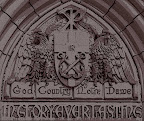Putting Women in Their Place
Recently, I've been reading Life Is Worth Living, a collection of talks from Fulton Sheen's television show. A fair number of the chapters are devoted to the take-down of communism, but most are surprisingly relevant and/or shockingly prophetic. The whole book is fantastic, and I could devote posts upon posts to it (really, it's just one great quote after another), but a few sections really stuck out at me. Among them is a chapter entitled "Women Who Do Not Fail", in which Abp. Sheen describes the three types of women who "keep civilization at a high level" (for he has already explained that "the level of any civilization is the level of its womanhood.").
He states what is often said, that all women are called to motherhood, be it physical or spiritual. However, before he even addresses the more commonly thought-of vocations of women, he looks at one that is, in my experience, often overlooked: How exactly do women in the professional world fulfill their call to motherhood? Are not such women doomed to lives of hardness and cutthroat competition? Not so, says Sheen:
The next type of women is the physical mothers, whose job it is not only to bear children, but also to teach obedience, for "mothers, more than politicians, are the preservers are freedom and democracy." In addition, the aforementioned feminine quality of equity, or mercy, complements the father's tendency toward justice. In this way, I suppose, the combined balance of justice and mercy between parents is an image to children of the justice and mercy of God, albeit in a much smaller and more imperfect way.
Finally, he addresses those who live out their vocation through spiritual motherhood. And their example is a lesson and an inspiration to the rest of society:
The chapter concludes with a reflection on the women who followed Jesus through His ministry and Passion: Mary Magdalene, who inspired people in the sociopolitical sphere; Mary, the mother of James, who taught her son such that he was willing to follow the Lord; and finally, the Blessed Virgin, "who left the lights and glamour of the world for the shade and shadows of the Cross, where saints are made." It is these women, examples for all women, who as Sheen points out, were closest to the Cross, and first to the tomb.
He states what is often said, that all women are called to motherhood, be it physical or spiritual. However, before he even addresses the more commonly thought-of vocations of women, he looks at one that is, in my experience, often overlooked: How exactly do women in the professional world fulfill their call to motherhood? Are not such women doomed to lives of hardness and cutthroat competition? Not so, says Sheen:
"A woman in professional life is happy when she has an occasion to be feminine....The woman who does not fail in the professional life is the woman, therefore, who manifests this feminine quality of 'equity'."It follows, then, that the women who do become embittered by professional life are the ones who, for whatever reason, are not given or do not take the opportunity to express their feminine call to motherhood. In my experience, these opportunities often come in small ways - remembering coworkers' birthdays, sewing on someone's wayward button, bringing in a bouquet of flowers to liven up the office. It's these small things, these chances to give, and to "mother" someone, that can keep a woman from completely losing herself in her job.
The next type of women is the physical mothers, whose job it is not only to bear children, but also to teach obedience, for "mothers, more than politicians, are the preservers are freedom and democracy." In addition, the aforementioned feminine quality of equity, or mercy, complements the father's tendency toward justice. In this way, I suppose, the combined balance of justice and mercy between parents is an image to children of the justice and mercy of God, albeit in a much smaller and more imperfect way.
Finally, he addresses those who live out their vocation through spiritual motherhood. And their example is a lesson and an inspiration to the rest of society:
"When spoiled lovers seek to make a false infinite out of a succession of finite loves, it is helpful to civilization to know there are some whose first love is their last love, and their last love is the love of God."Besides their example to the surrounding world, these women offer their lives and all their love for the sake of something greater, for the preservation of an ideal. Comparing them to soldiers who sacrifice everything for the sake of the patriotism and the love of their country, Sheen writes:
"Should there not be some women who will love God so deeply and so profoundly that they will sacrifice all lesser loves in order to preserve, for a week and sinful and possibly sex-minded world, the real understanding of love? They keep love pure."Despite the fact that they are often scoffed at, questioned, or mocked, these women have found something so beautiful that they are willing to forsake the visible, tangible love of marriage. And yet, they're so very happy with it (side note: there are several Nashville Dominicans here on a seemingly longer-term basis - by which I mean a few weeks so far - and those women are always. smiling. Like, even in situations that are really too mundane to cause happiness in most people, they're smiling. Clearly they've found something good.).
The chapter concludes with a reflection on the women who followed Jesus through His ministry and Passion: Mary Magdalene, who inspired people in the sociopolitical sphere; Mary, the mother of James, who taught her son such that he was willing to follow the Lord; and finally, the Blessed Virgin, "who left the lights and glamour of the world for the shade and shadows of the Cross, where saints are made." It is these women, examples for all women, who as Sheen points out, were closest to the Cross, and first to the tomb.












<< Home